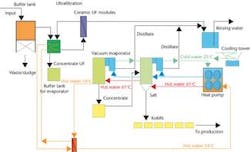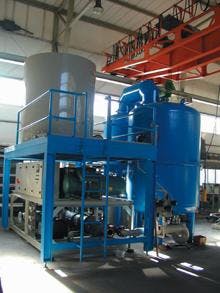By Oliver Rappich
Synergy between different industrial wastewater treatment and waste recycling techniques can result in reduced energy consump-tion, investment costs and space requirements.
The Austrian-based BWT CWT Group discovered these benefits following several years of research when the company explored several combined processes as marketable systems to optimise waste treatment. Group member Goema AG, based in Vaihingen, Germany, made inroads into four combined processes.
Membrane technology followed by evaporator technology: In the field of industrial waste recycling, combining evaporator technology with membrane technology reduces energy consumption. Membrane technology provides pre-concentration of effluents, thus minimising the required dimensions for the evaporator. Furthermore, excess heat from the thermal stage is used in the membrane process to achieve higher flow rates.
Figure 1 shows the general layout of such a combined process. A salt solution is concentrated by means of ultrafiltration (UF) and the concentrate is fed to the vacuum evaporator. The steam is fed into a tank together with permeate and the concentrate accumulated in the evaporator is dried, poured into moulds and returned to the production process. Cold and hot water are recirculated.
Evaporator technology followed by membrane technology: This combined process can be used in industrial waste recycling in order to increase the quality of the distillate, for example distillates from emulsion treatments (see Figure 1). The processes are optimised for each application and combined in such a way that energy input is minimised.
Vacuum evaporator for pre-concentration combined with a vacuum dryer with scraping system for final concentration: More process technologies may be combined if a specific consistency of the product must be reached for industrial waste recycling. The combination of vacuum evaporation with vacuum drying can lower energy consumption. This combined process helps achieve production-integrated environmental protection conforming to the zero discharge principle. The capacities of these thermal separation systems vary from approximately 100 litres per hour (l/h) to 4,000 l/h per module.
Biological wastewater treatment + membrane separation combined with biological treatment: Biological wastewater treatment processes can be used successfully in industrial wastewater treatment when most wastewater constituents are biodegradable (BOD/COD-ratio > 0.5). In general, the prime objective of wastewater treatment is the reduction of the COD/BOD value in order to allow direct discharge into open water or indirect discharge into a municipal sewage treatment plant. Biological treatment processes are frequently used for wastewater originating from facilities that process foodstuffs or natural products.
Combined process applications
Numerous facilities in the metal working, metal finishing, printed circuit board (PCB) and electronics industries discharge effluents containing both organic and inorganic components. Since these effluents contain many non-biodegradable or persistent substances, their treatment is only possible through a combination of a biological treatment with other treatment processes.
Goema AG planned, built and commissioned more than 20 plants in various industries in which biological treatment processes are implemented either as the sole process technology or in combination with other processes. Two-thirds of these plants are a combination of biological treatment processes with other processes. In most of these cases, wastewater is pre-treated by a membrane or sedimentation/flocculation process prior to the biological treatment stage.
Industrial wastewater treatment facilities in Turkey, Brazil and the People's Republic of China, where the Goema plants were installed, generally handle the entire effluent of the industrial facility.
This means that the wastewater is a mixture of the effluent from the physical-chemical pre-treatment of the facility, the sanitary and kitchen effluents of the facility, and in some cases, the wastewater from surrounding facilities and/or residential areas.
Approximately 45% of the plants were installed in production facilities of the automotive and the automotive supply industries. Some 30% are installed in the food manufacturing industry and 20% in the electronics and PCB industry.
Approximately 80% of the installations use aerobic treatment processes based on the classic activated sludge process, in which bacteria removes biodegradable wastewater constituents in a well-aerated basin.
Wastewater is then treated mechanically prior to the biological treatment step. Conventional screens and rakes remove solid and coarse matter. If necessary, grease and oil separators are fitted.
Following mechanical pre-treatment, wastewater is fed to a blending and equalising basin to ensure a constant quantity of pollutants in the water discharged into activated sludge basins (bioreactors). The bioreactor may be designed to operate on the continuous principle or the sequential batch reactor (SBR) principle. The decision as to which of the two processes should be used is made individually, depending on the volume of wastewater, its composition and the customer's wishes.
Regardless of the biological process, bacteria are suspended in the bioreactor and kept in suspension by aeration and/or agitators. Since pollutants nourish bacteria, the bacteria multiply within the reactor. Thus, some of the bacteria, the so-called "biological sludge," must be removed regularly. In the continuous process, this is done in a separate unit, the so-called final clarification basin. In the SBR process, the biological matter is removed from the bioreactor in the intervals between treatments of the batches of wastewater.
An alternative to the activated sludge process in biological wastewater treatment is the fixed-bed process, in which various materials are colonised with bacteria. This technology is used specifically where the bioreactor has to be colonised with specialised but slowly growing micro-organisms in order to achieve a continuously high degradation capacity for persistent matter. Such a fixed-bed bioreactor was built for the treatment of alkali-resist effluents in a PCB facility. Despite the high cleaning demand of 150 mg COD/l (direct discharge), this plant has operated for several years without problems or deficiencies.
For example, an Italian light-bulb production company has operated a treatment plant with a fixed-bed bioreactor since August 2001 to treat wastewater containing large amounts of nitric acid. Specific bacteria, so-called denitrifiers (or denitrifying bacteria) are bred in the fixed bed and capsule-immobilised in a special production process. The capsule-immobilised bacteria have a very high specific nitrate conversion capacity (approximately 2.5 kg NO3/m3xd), thus making it possible to keep the reactor dimensions very small. On average, the nitrate concentration in the effluent of the plant is far below the required limit value of 10 mg/l. With a feed concentration of more than 3,000 mg/l, the plant has a nitrate removal efficiency of 99.7 %. The excess biological sludge, which results from bacterial activity, is removed by crossflow microfiltration. The permeate is clear and could in principle be recycled for use within the facility.
In summary, some manufacturers have made such progress in the development of evaporator technology that almost any persistent matter can be treated with the adequate combination of process and technology.
Author's NoteOliver Rappich is the head of Process Technology and Marketing for Goema AG, based in Vaihingen, Enz, Germany.Vacuum evaporator lowers energy costs
Goema AG's new vacuum evaporator with internal heat exchangers can be cleaned mechanically.
Heating and cooling energies are transferred between stages by means of loops carrying thermal media in order to optimise the energy consumption of this system. Excess heat resulting from the use of heat pumps is used in the production of cooling energy, which helps reduce heat pump dimensions and minimise heat loss. Consequently, this reduces investment and energy costs.
The vacuum is built up within a few minutes with a vacuum unit developed by Goema AG. The heat exchanger surfaces in the boiler chambers, which can be cleaned mechanically, ensure a uniformly good heat transfer by avoiding encrustation and film deposits. This feature results in lower energy costs and less maintenance.
In the vacuum evaporator, the condensation of water vapour in the floating concentrated layer containing organic substances must be prevented. For example, this can occur during the evaporation of oil/water mixtures or emulsions. To prevent condensation, the watery solution under this "organic" layer is pumped through a circulation pipe equipped with a heat exchanger to the surface of the fluid phase, where it is sprayed. This step leads to a far higher effectiveness in the concentration of solutions.
All plants are optimised specially for the product to be treated, thus guaranteeing the required capacities. The product capacities of this new vacuum evaporator technology vary between 100 l/h and approximately 5,000 l/h per module. Various modules may be joined to form a useful and economic combination for the particular requirement. The correct design and dimensioning of the systems must be given special attention to ensure the suitability of the technology.
Guaranteed and comprehensive service and detailed user training are of great importance for evaporator plants that are directly integrated into the production process within the framework of a "clean galvanisation" process.





